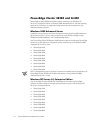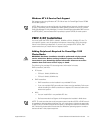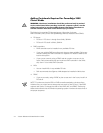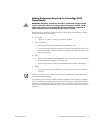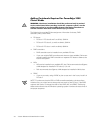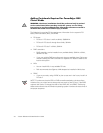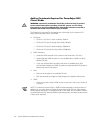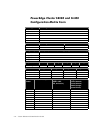
support.dell.com Cluster SE300 and SL300 Platform Guide 1-3
Windows NT 4.0 Service Pack Support
Dell recommends using Windows NT SP 6.0a or later for PowerEdge Cluster SE300
and SL300 systems.
NOTE: Both nodes must be configured with similar drivers (network interface control-
ler [NIC], redundant array of independent disks [RAID] controller, and so on), utilities
(Dell OpenManage™ Array Manager), firmware (PowerEdge expandable RAID control-
ler [PERC] 3/DC), and the latest basic input/output system (BIOS) for each system.
PERC 3/DC Installation
You must install the PERC 3/DC in a 64-bit, 33-MHz or 32-bit, 33-MHz PCI slot. For
your specific system, see the peripheral component interconnect (PCI) slot assign-
ments in the following subsections. If you are using multiple PERC 3/DCs, Dell
recommends that you install them on separate buses.
Adding Peripherals Required for PowerEdge 1550
Cluster Nodes
WARNING: Hardware installation should be performed only by trained
service technicians. Before working inside the system, see the safety
instructions in your PowerEdge System Information document to avoid a
situation that could cause serious injury or death.
The following list provides PCI slot assignment information for buses,
RAID controllers, and NICs:
• PCI buses
— PCI bus 1: 64-bit, 66-MHz slot.
— PCI bus 2: 64-bit, 66-MHz slot.
• RAID controllers
— RAID controllers can be installed in any available PCI slot.
— If you use multiple RAID controllers and there are slots available, Dell recom-
mends installing the RAID controllers on separate PCI buses to balance the
load on the system.
• NICs
— You can install NICs in any available PCI slot.
— Dell recommends that Giganet cLAN adapters be installed in 64-bit slots.
NOTE: To make sure that the small computer system interface (SCSI) or RAID control-
ler attached to the boot drives initializes first, you might have to change the scan order
of the PCI bus, if the BIOS supports this option, or change the order of the RAID, and
NIC. Performing these tasks ensures that the Windows operating system numbers
the boot drives in the proper sequence.






